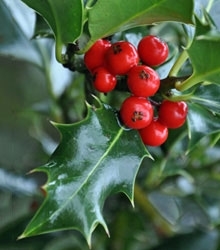Holly
 I recently visited an estate in Sussex as part of my work and while walking the land with the owner, I noticed that many of the hedges had holly trees growing quite regularly along them, having been allowed to grow up and not be trimmed back to form part of the hedge. When I commented on this, he immediately replied, “Oh yes, that’s to stop the witches from running along the hedge tops.” When I chuckled at this, he told me that his father, who had lived and worked all his life on the farm, had been told of this by local farm workers and although he didn’t believe in such nonsense, it was obvious that he had never ever cut any of them down!
I recently visited an estate in Sussex as part of my work and while walking the land with the owner, I noticed that many of the hedges had holly trees growing quite regularly along them, having been allowed to grow up and not be trimmed back to form part of the hedge. When I commented on this, he immediately replied, “Oh yes, that’s to stop the witches from running along the hedge tops.” When I chuckled at this, he told me that his father, who had lived and worked all his life on the farm, had been told of this by local farm workers and although he didn’t believe in such nonsense, it was obvious that he had never ever cut any of them down!
I love stories like this and the countryside is, of course, full of such beliefs and traditions, passed down through generation to generation. It made me start to think of the role that holly plays in our culture, especially during this festive season. Why is holly so often the chosen plant for making wreathes and decorations at Christmas time?
The tradition of bringing holly into the house at Christmas time is most probably linked to the rebirth of the sun at the midwinter solstice (21 December). Holly is at its most glorious at this time of year, being fully-leaved and covered in gloriously bright red berries, and it symbolised life and fertility at a time when most other trees were naked and dormant. The yule log was burnt on solstice day by the Celtic druids and was either made of Holly wood or had holly branches laid over it. Each year the log was lit using the remains of the previous year’s yule log, which had been kept by the hearth to help ward off evil and death. Christians began to use holly at Christmas time, especially when creating wreaths, because the spines of the leaves symbolised Christ’s crown of thorns, and the red berries represented the drops of Christ’s blood.
Apart from Christmas time, holly has been important for many other reasons too. The wood is heavy (so dense that freshly cut wood sinks in water!), strong, and of a whitish colour, especially in the centre of the trunk. This pale wood was commonly used for making white chess pieces, while ebony was used for the black. Because the wood is so hard and compact it is ideal to polish, creating a very smooth surface, ideal for decorative inlay work on furniture, walking sticks, billiard cues and the hammers in harpsichords. Holly was for a long time also believed to have a power over horses and its pliable wood was therefore chosen for making whips. In fact, in the 19th Century when horses were used for ploughing, pulling coaches and most other means of transport, more than 2,000 whips per year were made using holly.
Holly was often planted next door to houses as it was believed to be a good lightning conductor and therefore should prevent the house from being struck. It was also planted as a component of hedges as it is one of the most stock-proof species and creates a dense impenetrable barrier that even the most determined cattle found hard to escape through. Holly was also planted in the landscape as an indicator for travellers or the farm worker, as being so easily visible it was grown next to stiles and also used as a focal point or “sightline” when ploughing or drilling. Because of its evergreen leaves, it was also widely used for fodder during the winter months, lopped off branches being fed to stock, a tradition that is still carried out in the New Forest for the ponies and cattle there. In the past, the bark stripped from young shoots of holly was fermented to produce a very sticky substance called birdlime. This was spread on to tree branches to ensnare birds, which were then either sold captive, or eaten.
So holly has been very widely used for all sorts of things in the past. Remember, however, that if you want a holly tree covered in berries in your garden to help you brighten up your Christmas, holly is dioecious, meaning a tree is either male or female. The male is needed in the vicinity of the female tree to enable pollination, and once fertilised it will then carry the festive red berries come winter time.
Peter Thompson
Advisory

Download Peter Thompson's essential 26-page book, featuring beautiful photography and detailed profiles of Britain's wildlife
Download FREE >